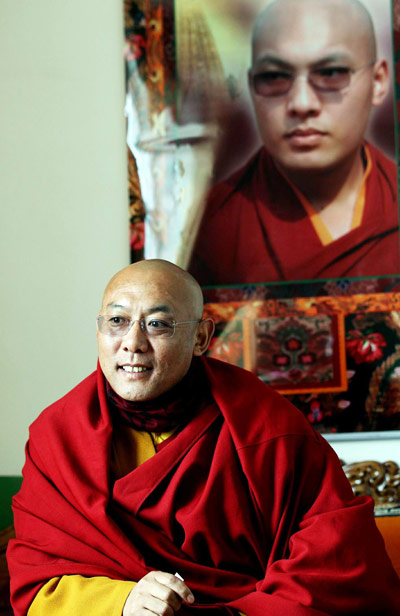Living Buddha sees blessings in earthquake
Updated: 2012-11-29 10:42
By He Na in Yushu, Qinghai (China Daily)
|
||||||||
 |
|
Living Buddha Lodro Nyima says the 2010 earthquake in his hometown Yushu, Qinghai province, gave him a better understanding of the meaning of life. Zhang Wei / China Daily |
For Living Buddha Lodro Nyima, the devastating earthquake in 2010 that razed his monastery to the ground turned out to be a blessing.
The earthquake has given him a better understanding of the meaning of life.
"Before the earthquake, I learned Buddhism only from books and other Buddhists.
"But after witnessing so many deaths and heartbreaking moments, I fully understood the meaning of life which deepened my understanding of the truth of Buddhism," says the 47-year-old.
A 7.1-magnitude quake rattled Yushu Tibetan autonomous prefecture in Qing-hai province, on April 14, 2010, killing more than 2,600 and injuring more than 12,000.
Lodro Nyima was giving a speech in Malaysia when the earthquake struck but managed to get the next flight home the next day.
When he arrived, he couldn't believe what he saw -the 750-year-old Trangu Monastery to which he has devoted all his energy over the past two decades had been flattened.
Located along the earthquake fault line, Trangu Monastery was the worst hit monastery during the quake.
More than 23 lamas were killed and many more were injured.
"Facing the ruins of the earthquake and the helpless eyes of lamas, I couldn't hide my sadness. But I told myself that I must control my feelings and stay strong for the people," says Lodro Nyima, who speaks Tibetan, Mandarin and English.
He organized the lamas to help each other and moved the injured to a small temple nearby. He also led a group of lamas to nearby villages to help out in rescue work.
They were the first batch of rescuers for some villages and saved many people. Lodro Nyima and his lamas also counsel and comfort those who had lost their relatives.
Lodro Nyima is a household name in Yushu, where 97.7 percent of the population is Tibetan and one sixth of Tibetans are monks and nuns.
Religion plays a leading role in the lives of the locals and to many worshippers, the monasteries are even more important than their own homes.
"Many villagers cried when they saw that the monastery had been destroyed," says Waba Tsering, 43, a Trangu Monastery lama.
"Before moving into new dormitories in November 2011, we lived in tents and prefabricated houses, but we continue to hold our puja (prayer meeting), for we knew that besides disaster relief supplies, the stricken worshippers need more spiritual help," Lodro Nyima says.
The lamas visited each disaster relief site to chant sutras for the departed and pray for the survivors.
"In Tibetan-Buddhism, the first 49 days are considered as the key period for the return of the departed. During that period, our living Buddha and lamas only slept three to four hours a day," says Waba Tsering.
The Living Buddha says the government gave a lot of help, including the construction of a new monastery.
"And after consulting us and receiving our consent, the reconstruction headquarters found new location for us where transportation is convenient and began rebuilding a new monastery," he says.
"Overcoming the strong altitude sickness, construction workers worked really hard, I really salute them."
At the end of 2011, the lamas of his monastery moved into new houses, much stronger and warmer than the old ones.
"We are very satisfied. The only sad part is the lost of the historical heritage.
Xu Fushun, executive vice-governor of Qinghai province, praised what Lodro Nyima did during the earthquake.
"Lodro Nyima acted as a bridge between the government and Tibetan people. He was indispensable during the disaster relief period and while we helped reconstruct Yushu," he says.
hena@chinadaily.com.cn

 'Taken 2' grabs movie box office crown
'Taken 2' grabs movie box office crown
 Rihanna's 'Diamonds' tops UK pop chart
Rihanna's 'Diamonds' tops UK pop chart
 Fans get look at vintage Rolling Stones
Fans get look at vintage Rolling Stones
 Celebrities attend Power of Women event
Celebrities attend Power of Women event
 Ang Lee breaks 'every rule' to make unlikely new Life of Pi film
Ang Lee breaks 'every rule' to make unlikely new Life of Pi film
 Rihanna almost thrown out of nightclub
Rihanna almost thrown out of nightclub
 'Dark Knight' wins weekend box office
'Dark Knight' wins weekend box office
 'Total Recall' stars gather in Beverly Hills
'Total Recall' stars gather in Beverly Hills
Most Viewed
Editor's Picks

|

|

|

|

|

|
Today's Top News
Health new priority for quake zone
Xi meets US top military officer
Japan's boats driven out of Diaoyu
China mulls online shopping legislation
Bird flu death toll rises to 22
Putin appoints new ambassador to China
Japanese ships blocked from Diaoyu Islands
Inspired by Guan, more Chinese pick up golf
US Weekly

|

|






